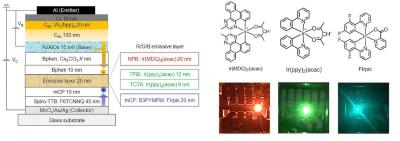Researchers from Dresden's Technical University (TUD) developed a new OLED device structure that combine vertical organic permeable base transistors (OPBT) and OLEDs materials - organic permeable base light-emitting transistor, or OPB-LET.
The new design successfully combines the function of a highly efficient switching transistor and an organic light-emitting diode. The OLED transistors (OLETs) are three-terminal devices combining a thin-film transistor with a light-emitting diode. Unlike previous OLETs, the OPB-LET offer high performance, thanks to the permeable base electrode located at the center of the device. The electrode forms a distinctive optical microcavity and so regulates the charge carrier injection and transport.
The researcher report that the structure offers high efficiencies (up to 24.6% EQE), high luminance (up to 12,513 cd/m2) and low driving voltages (


